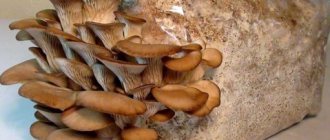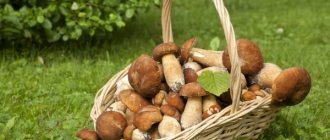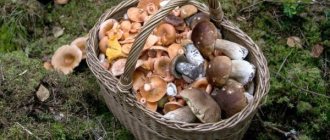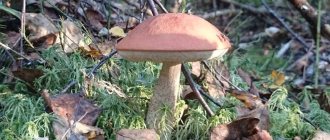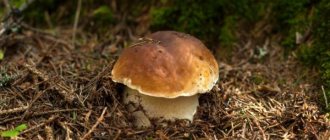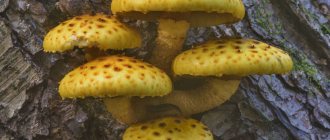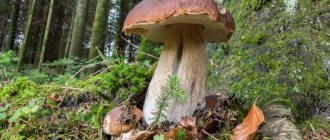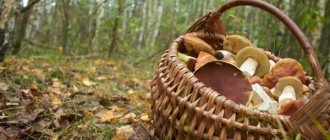- home
- Nature
- Cap mushrooms
Elena Golets22 December 2014 17543
The structure of mushrooms varies depending on their species. Most edible mushrooms consist of a stem and a cap, which is where their name comes from - cap mushrooms . Their spore-bearing layer is located at the bottom of the cap.
Cap mushrooms are divided into lamellar and tubular depending on how their spore-bearing layer is built. Mushrooms that have spores inside a special organ, the ascus, or bursa, are called marsupials. These include morels and lines. There are mushrooms that have spores inside the mushroom itself. These include all types of puffballs and truffles, (more details: Spring mushrooms)
Reasons for the growth of mushrooms on tree stumps
Individuals settling in this way are classified as saprophytic fungi that feed on the remains of various microorganisms. They parasitize on the body of a stump or living tree, destroying the wood. Fungal spores spread in areas of damage, forming mycelium, which allows the fungi to go deeper into the wood, affecting it.
Causes of mushrooms on stumps:
- Mechanical damage (cutting, breaking).
- Irregular garden care.
- Pest damage to trees.
- Special colonization of fungal spores on stumps or trees for the purpose of growing edible species.
Wood-destroying edible mushrooms grown in households or on large farms (honey mushrooms, oyster mushrooms, shiitake mushrooms) have become a source of good profit in modern business.
Poisonous wood-destroying organisms cause irreparable damage to fruit trees, leading to their death and contamination of the entire garden. Therefore, trees affected by such parasites should be uprooted and destroyed in a timely manner to prevent the spread of fungal spores to other plants.
Edible types of mushrooms growing on stumps
Edible mushrooms are sometimes difficult to recognize, but the special features are clearly visible in the photo, and you just need to remember the name and description of each.
The most popular edible mushrooms, growing on living or rotten wood in nature or grown artificially, are red and yellow honey mushrooms, located in nature in groups on old coniferous stumps (spruce, pine). They find their wide application in cooking. They are pickled, fried, canned, salted, without fear for their health.
Due to the content of a large number of microelements (copper, zinc) involved in the formation of blood cells, eating honey mushrooms has a beneficial effect on the body. However, among honey mushrooms there are their doubles, which are called false and are poisonous. A distinctive feature is the presence of a ring on the stem of edible fruits. There are such varieties of edible mushrooms:
- winter honey fungus (Flammulina velutipes). Often noticeable due to its bright orange color. The cap has a smooth transition from bright to dark shades, condensing towards the center. The leg is covered with small fibers. The pulp is whitish, with a pronounced mushroom aroma. Due to its good resistance to low temperatures, winter honey mushrooms can be found in winter under the snow on damaged wood of deciduous trees (willow, poplar);
Other edible mushrooms:
- oyster mushroom (Pleurotus cornucopiae). The funnel-shaped cap of a light gray color (3-12 cm) gave the oyster mushroom its name. The leg is centrally located, (2-6 cm), covered with small plates. White, somewhat compacted dense pulp with a delicate odor. You can observe the spread of oyster mushrooms on deciduous stumps;
Although the presented varieties of mushrooms are edible, they require careful heat treatment before cooking.
About everyone and everything
The roots of each tree have their own yar or yarnu, that is, as was believed in the old days, the plant power of the soil, especially transferred to mushrooms, therefore only under a certain tree can a mushroom grow and develop, and under any other it will not grow. The great Russian master of mushroom hunting and quiet hunting, Dmitry Zuev, in his wonderful book “Gifts of the Russian Forest” (Publishing House “Forest Industry”, Moscow, 1966) emphasized: “A mushroom without a tree and a tree without a mushroom are not residents.”
So, what trees do mushrooms grow under?
Under the birch: white truffle, white mushroom (short-legged), dubovik (double of the white one), sinik-krasik (double of the boletus mushroom), real milk mushroom (mokhnach), obabok, aspen mushroom, black mushroom berezovik, caesarean mushroom (edible double of the fly agaric), food russula , cobweb, violet row, pushers to (float), red fly agaric, wave, thin pig, green russula, deer sponge, valui.Under the oak: white mushroom (long-legged), speckled oak (white double), blueberry (white double) ), satanic mushroom (an inedible double of the white and oak mushroom), oak mushroom, milkweed (under-nut), pepper milk mushroom, pink russula, gladish milkweed (alder), Caesar's mushroom (edible double of the fly agaric), white mushroom (white trumpet), pigweed, deer sponge, green russula, dry milk mushroom, blue milk mushroom, violin, valui, red fly agaric.
Under the aspen: red aspen, aspen milk mushroom, dog milk mushroom, russula, valui.
Under the spruce: porcini mushroom (the real and most valuable spruce boletus), white truffle, red saffron milk cap, aspen boletus, black birch mushroom, typical raw milk mushroom, black and yellow milk mushroom, red russula (spicy), valui, svinushka, chanterelle, red fly agaric .
Under the pine tree: boletus mushroom (strong boletus mushroom), white mushroom (double of boletus mushroom), orange saffron milk cap, curly drigel (head mushroom), real oiler, green boletus mushroom, yellow-brown boletus mushroom, Polish mushroom (chestnut boletus mushroom), dark red russula , yellow kolchak (blackberry), brittle russula, cobweb, violet row, pigwort, red fly agaric.
Poisonous and inedible types of mushrooms
There are much more unedible mushrooms that like to settle on stumps than edible specimens. If they enter the body, they cause irreparable harm. Inedible mushrooms growing on stumps are represented by Ganoderma, Ischnoderma, Postia and others; from the photo and detailed description, one can identify special characteristic features that other species do not have:
- southern ganoderma (Ganoderma australe). This mushroom is distinguished by a compacted, rather large cap 40 x 13 cm, dark brown in color. The leg is not clearly defined. The brown flesh is soft. Favorite places to grow: poplar, oak, linden stumps;
Having a beautiful appearance and aroma, inedible mushrooms attract the eye and are easily confused with edible specimens, so you should pay special attention to their description.
Doubles
The real saffron milk cap is a relative of the spruce saffron milk cap. Outwardly, they are quite similar, have an identical structure of caps and legs, both are introduced into the forest, and also have the same taste.
Real saffron milk cap
Spruce saffron milk cap has many false doubles: red saffron milk cap, pink saffron milk cap, and so on.
Red saffron milk cap
Pink wave
Mushrooms used in folk medicine
There are varieties of mushrooms of this type that are effectively used in folk medicine to treat various diseases; they are added to medicinal tinctures, decoctions, and added to ointments:
- larch sponge (Fomitopsis officinalis) or agaricus. The mushrooms are white or pale yellow in color, oblong in shape, similar to an animal’s hoof. They can reach 10 kg in weight. They grow on coniferous trees or larch stumps. When used as part of a medicine, it weakens, stops bleeding, calms, and acts as a mild sleeping pill. Used to reduce sweat secretion;
Answers to common questions
When going out hunting, mushroom pickers look for the desired prey on the ground, forgetting about useful edible specimens, which prefer stumps and trees. Don’t be upset if there is no forested area nearby; you can grow wonderful mushrooms yourself by taking recently cut down stumps and adhering to certain rules.
Mushrooms that grow on trees and stumps are either edible or unsuitable for food. They use wood as a nutrient substrate. Some types of such fungi are parasitic, violating the integrity of living tissues; others process dead wood and become food for birds and animals. Medicinal compositions are prepared from some types of tree mushrooms.
Edible tree mushrooms
On stumps and trees you can see many edible mushrooms. This:
- Wild oyster mushrooms . In turn, they are divided into types such as lung, orange, and carob mushrooms. They grow in forests with deciduous trees. You can find wild oyster mushrooms on the stumps of rowan and oak trees from May to September.
- Winter honey fungus . These mushrooms have a convex brown cap and stems covered with hairs. They can be seen on damaged deciduous trees. Winter honey fungus often inhabits dried poplars and willows. It bears fruit from autumn to spring, and can even overwinter under a layer of snow.
- Liverwort . The tree mushroom received this name due to its color, which approaches a bloody tint, and dense, fleshy pulp: its cut resembles raw liver. In shape it resembles a tinder fungus. The color of the liverwort cap is red-brown. This mushroom grows on living trees, mainly on chestnuts, oaks, and less often on other deciduous trees. The liverwort should be eaten only when the mushroom has not yet aged. Winter honey fungus.
- Real (or autumn) honey mushrooms . The color of these mushrooms varies: light brown, brownish, reddish. They grow on the stumps of acacia and poplar. There must be a light membranous ring on its thin leg. This is a distinctive feature of the edible honey mushroom.
- Curly griffola (or ram mushroom) . The fruiting body of this mushroom is branched and has many caps. The diameter of the mushroom “bush” can reach 80 cm and weight – 10 kg. Ram mushroom is the largest variety of mushrooms growing on trees. Color – gray, brown, yellowish-brown. Curly griffola is collected in August and September in forests with broad-leaved trees. They are found on the bases of maples and old oaks, beeches and chestnuts.
- Tiger sawleaf . The color of this tree mushroom is white or slightly yellowish. On its surface there are black and dark brown scales. The flesh of the mushroom is tough. Saw leaf contains a large amount of protein. It is collected from mid-summer to October.
- Coral blackberry . This mushroom has a specific appearance: it has a large, well-developed aerial part. Its fruiting body resembles a sea coral bush in appearance: it has many short tentacles. The color of blackberries varies from snow-white to cream with a slightly yellowish tint. This mushroom grows on fallen trees and in old hollows. Preferred trees are elm, oak, linden, beech. This mushroom can be added to various dishes, and medicines can also be prepared from it.
- Edible tinder fungi . They grow both on living trees and on the stumps of coniferous or deciduous crops. Sometimes tinder fungi grow in gardens and on fruit trees. The most common type of edible tinder fungus is the variegated, or tree, mushroom. A sulfur-yellow mushroom is also found. They grow from May to September. Outwardly, they resemble large, flat, overripe chanterelles. The diameter of the cap varies from 10 to 40 cm.
Tree mushrooms are useful for those who suffer from diabetes, obesity, anemia, and high blood pressure. They also protect the body from harmful substances and remove waste and toxins.
Based on medicinal tree mushrooms, compositions are prepared that improve the patient’s condition. The following recipes are known:
- Tea made from lacquered tinder fungus. To prepare it, you need to dry the mushroom and grind it to obtain a powder. You need to take 2 tablespoons of the resulting powder per 400 ml of cold water. Put the mixture on the fire, boil for 5 minutes, then pour into a thermos and let it brew for 10-12 hours. The finished decoction should be taken 2 tablespoons 3 times a day, 40 minutes before meals. The course of treatment is 3 weeks, after which you need to take a break for a week. After this, the therapeutic course can be repeated.
- Infusion of birch chaga. Take a large mushroom, soak in cold water, leave for 5 hours. After this, grind everything, add hot water (the ratio is 1 part chaga infusion to 5 parts water). Place the infusion in a dark place and leave for 2 days. Take 3 glasses of infusion per day.
Preparations based on these tree fungi have a good effect on blood vessels and the heart muscle, eliminate the symptoms of cardiac ischemia, normalize blood circulation in the vessels of the brain, and also improve memory.
False chanterelles are cat's gold. How to distinguish false chanterelles
The real decoration of the forest is the chanterelles. These cute and tasty mushrooms are also very healthy. They are extremely rich in carotene and also contain a lot of vitamin C and polysaccharides. They have an anthelmintic effect and improve liver function. It is even believed that chanterelles help remove radioactive nuclides from the body.
The only problem is that they have a very similar double - false chanterelles or, as they are also called, orange talkers. They also have a beautiful Latin name Hygrophoropsis aurantiaca. These mushrooms are not related to the true chanterelle family, which has several varieties of mushrooms. They are similar to them only in appearance. False chanterelles belong to the so-called conditionally edible mushrooms, that is, after soaking in water and heat treatment, they can be eaten. But they don’t have much benefit, and their taste and smell are so-so. Experienced mushroom pickers distinguish these mushrooms on an intuitive level. But if you are a beginner mushroom picker, you shouldn’t rely on intuition alone. How to distinguish false chanterelles from real ones? Let's try to figure this out. Where and how do these mushrooms grow?
False chanterelles can be found in coniferous and mixed forests. They grow on dead wood, on old rotting trees, on the forest floor, and in moss. Late summer and autumn are the times of their greatest numbers. False chanterelles can grow either in groups or individually. Real chanterelles are also residents of coniferous and mixed forests. They grow on the soil, in moss, under leaves. But, unlike false chanterelles, you will not see them on old fallen trees. And if you find one fox, you can be sure that there will be many nearby. They almost never meet alone!!! Cap color
The false chanterelle is brighter in color than the real one. Most often it is bright orange or orange with a brown tint, and the edges are always lighter than in the center. The surface of the cap is slightly velvety. In a real chanterelle, the color of the cap can vary from light yellow, sometimes almost white, to yellow-orange. She will never be as “red” as a deceiver - a false fox. The color of her cap is the same both in the center and along the edges. Its surface is smooth. Shape and size of the cap False chanterelles can also be distinguished by the shape of the cap. The false chanterelle's cap edges are even and smooth, neatly rounded. The cap is small in size, no more than 3 - 6 cm in diameter. In an adult mushroom it is in the form of a funnel, in a young one it is slightly convex. A real fox has a hat with wavy edges, almost always irregular in shape. Its diameter is larger, sometimes reaching 12 cm. The hat of young foxes is also slightly convex. As it grows, it becomes flat, then depressed, and in old mushrooms it becomes funnel-shaped. Its edges are curved down. Mushroom plates
In the false chanterelle, the plates are thinner and more frequent, branching, orange, descending onto the stalk, but not turning into it. In a real chanterelle, the plates are denser, thicker, going down the stem of the mushroom, turning into it. Mushroom pulp The flesh of false chanterelles is yellow, has an unpleasant odor, tasteless and loose. When pressed, its color does not change. In real chanterelles, it is white in the middle, and yellow only at the edges, dense. If you press on it, its color turns reddish. It has a pleasant smell and tastes sour. Leg In false chanterelles, the leg is thinner, orange-reddish, and when cut through an adult mushroom it is hollow. The color below is darker. The shape of the leg is cylindrical, without narrowing downwards. The cap is clearly separated from the stem. Real chanterelles have a thicker leg; it is never hollow. In real chanterelles there is no distinction between the cap and the leg. It is the same color as the cap or slightly lighter, smooth and dense, tapering downwards. Spores False chanterelles have white spores. The real ones are yellowish. Another difference is that real chanterelles are never wormy. This is due to the fact that the mushroom contains chitinmannose, which has an anthelmintic effect. The larvae deposited by insects die under its influence, so chanterelles can grow for a long time. At the same time, old mushrooms sometimes acquire a bright orange color. It is not recommended to eat them because they can cause poisoning. False chanterelles do not have chitinmannose, so insect larvae can infect them.
Is it possible to eat false chanterelles? Yes, you can, although you wouldn’t call them particularly tasty. Like all conventionally edible mushrooms, they must first be soaked for 3 days, changing the water in the morning and evening. After this, they are boiled in boiling water for 15 minutes. Boiled false chanterelles can be fried or pickled. In truth, it is worth collecting them only when there is nothing better in the forest. Hopefully you will be lucky and find more tasty and healthy mushrooms. Happy and successful mushroom hunting!
Inedible poisonous mushrooms growing on trees and stumps
Inedible parasitic mushrooms can also grow in these places. They are not suitable for human consumption and cause severe poisoning. Some of them are not poisonous, but should not be eaten.
These mushrooms include the following types:
- Ganoderma southern . It grows from a tree. This mushroom has practically no stem, and the cap is flat. The wide part of Ganoderma grows to wood or soil. The flesh is dark, soft and tender.
- Fluffy trametes . This inedible tree mushroom has a gray surface and leathery flesh. It often grows on the wood of coniferous trees, as well as on birch trees. Trametes usually occurs on stumps.
- Piptoporus oak . The mushroom has a large fruiting body. The diameter of the hat is 10-15 cm, its surface is velvety. Color varies from white-yellow to brown. Most often, piptoporus grows on oak bark.
These types of mushrooms should not be eaten even after careful heat treatment. If the mushroom is unknown, it is better to leave it on the tree.
"Mother-in-law's tongue" or liverwort
In oak groves, mainly on oaks or in their root zone, “mother-in-law’s tongue” grows. There is no need to cook it, just cut it, bread it in breadcrumbs or flour and fry it. You can make chops from mushrooms. The taste is reminiscent of liver, but due to the high content of vitamin C it has a sour taste. Anyone who doesn’t like sour things won’t like these mushrooms.
Liverworts grow from early spring, but begin to appear in large quantities at the end of August, and they can be collected until frost. On one oak tree you can find 2-3 mushrooms. Try to cut off the younger ones.
Liverworts are sometimes covered with a light mucus. They are white below, sometimes red, and a reddish liquid is released on the cut. You will not confuse this mushroom with any other.
Features of growing mushrooms on stumps
The types of mushrooms that grow on stumps can be grown at home, creating conditions for them that are as close to natural as possible. The best option is to grow tree mushrooms in your summer cottage.
For stumps, you need to use sections of wood from deciduous trees, or use real stumps left over from recently cut down trees.
Most often, oyster mushrooms are grown on the site. To ensure their growth and normal development, you need to take poplar, birch, and maple wood. Coniferous species should not be used, as they contain a large amount of caustic resins that can destroy the mycelium.
If fresh wood is used, there is no need to soak or moisten it first. If the stumps are old, then they need to be kept in a container with cold water for several days.
After the logs are ready, you can add the mycelium of the selected type of tree fungus. To do this, you can make holes in the hemp in a checkerboard pattern. Their depth should not be more than 6 cm, and their diameter should not be 1 cm.
Mycelium should be poured into these holes. After this, they need to be covered with moss or closed with adhesive tape.
Logs with mycelium must be placed in the basement. They should be folded into a pyramid shape and covered with burlap.
The stumps should remain indoors until the mycelium germinates. After this they can be placed in the ground. It is recommended to do this in May, when normal temperatures have established.
To plant stumps, you should choose a shaded place. You need to dig a hole no more than 15 cm deep, line the bottom with wet leaves or sawdust. You need to place a stump in the hole. The distance between each of them should be at least 35 cm. The stumps should be watered if necessary.
Another way is to grow tree mushrooms in a trench. You can do it this way:
- Dig a trench up to 15 cm deep.
- Pour dry pearl barley onto the bottom, which will provide the mycelium with good nutrition.
- Place disinfected mycelium on top. Each stump should contain 300 g of seed.
- Place the moistened stumps on the mycelium and lightly sprinkle with soil.
After planting tree mushrooms, you need to water the soil. This must be done carefully, since excess moisture does not benefit the growing mushrooms. It is best to use a spray bottle for watering. Watering should be done during dry periods.
For the winter, the mushroom plantation should be covered with a layer of straw or foliage. It is necessary to cover the stumps with material so that the mushrooms do not freeze.
The first harvest, if everything was done correctly, can be harvested within a month after planting the mycelium.


